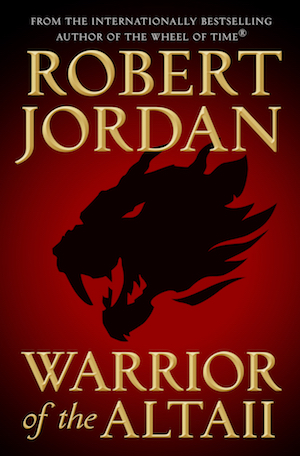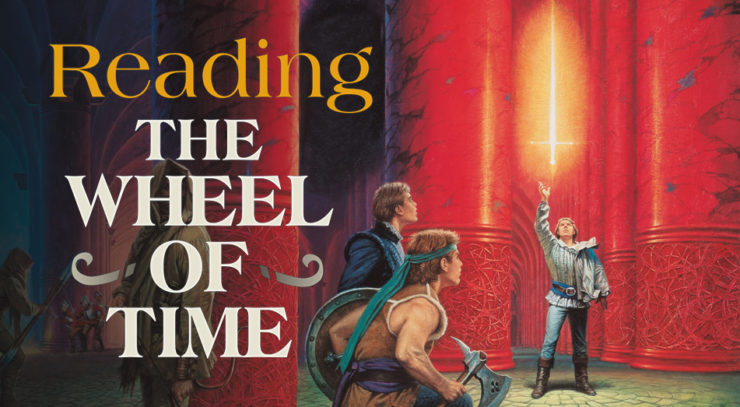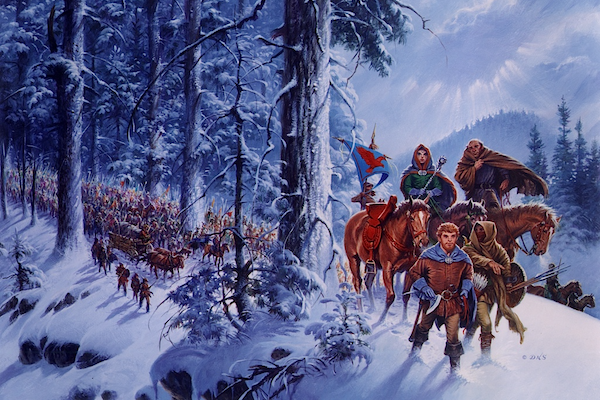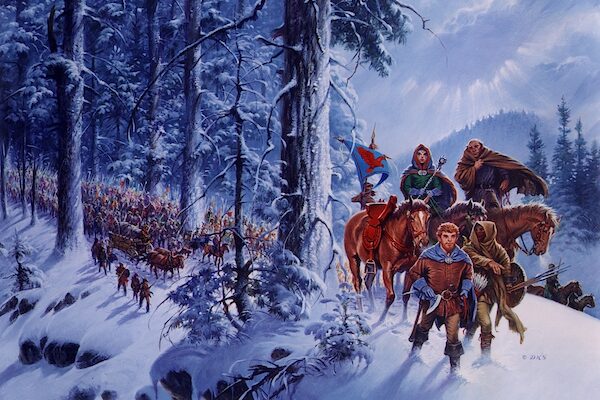Good morrow to you, fair readers, here on this lovely week 14 of our read of The Dragon Reborn. We’re doing two more chapters this week, Chapters 33 and 34, in which Perrin grapples with questions about the nature of the Pattern and meets an Aielman in a cage, just as Min promised. But why is this stranger important for Perrin? We’ll have to read on to find out.
Chapter 33 opens with Perrin studying a strange mark, like a giant dog’s footprints, in a stone. There are no other marks in the softer ground, not the scent of a dog’s trail, although Perrin catches something sulfurous, like the distant scent of fireworks.
They are pushing hard towards Jarra, even Loial yawning in his saddle. The Ogier is perplexed by Perrin’s inability to sleep, given how worn they all are from the traveling, but even besides the danger of Perrin’s dreams and how much he doesn’t want to have to acknowledge Hopper, he’s increasingly disturbed by the affects of Rand’s passage through various towns, which sometimes results in great fortune for the people, and sometimes in disaster. An entire town burned down here, the discovery of a long-lost cache of gold there, and Rand still managing to stay ahead of them, even though they found his horse dead—and mauled as if by wolves or wild dogs—outside of Jarra and he’s apparently now foot.
Buy the Book


Warrior of the Altaii
When Perrin, disturbed that a ta’veren presence could cause evil in the world, asks Moiraine about the negative effects that Rand’s presence has had on some of the towns, she explains that, while the Creator is good and the Dark one is evil, the Pattern itself, the Wheel itself, is neither, and that both the good and the bad make up the weave. Perrin finds the idea that good and bad are incidental even more disturbing than if the bad things were a deliberate choice by the Pattern.
When they reach the town of Remen, Moiraine hides her Aes Sedai face in her hood while Loial draws interested murmurs from the crowd, but Perrin is more caught up with the strange smell that he detects in the air—a wrong smell, like the one he caught in Jarra, not that of Shadowspawn but just as twisted and vile. Then he catches sight of a man suspended in a cage in the town square, sitting unmoving as children throw rocks at him. None of the townspeople stop the children either, but look on with a mixture of approval and fear.
At the town inn they discover a common room full of people in celebratory clothing, everyone—except four trading ship captains talking separately in one corner—seeming animated and excited, even the serving women. They learn from the innkeeper, Gainor Furlan, that Hunters for the Horn are in town, and that the men found adventure here in the form of a band of Aielmen, whom they fought. As the two men, Lord Orban and Lord Gann, told the tale, they and ten retainers encountered a band of twenty Aiel and fought a hard battle, with six of the retainers being killed and the rest wounded, including the two lords, while all the Aiel were either slain or fled, save the one captive now in the cage.
Lord Orban shows himself to be a disagreeable sort as he stumps around demanding “that old woman with her herbs” and complaining of his and his friend’s pain, despite Furlan’s reassurances that Mother Leich took care of their wounds and they will be fine until she returns from helping with a birth. Lan and Loial question the man about the fight with the Aiel, but Moiraine cuts Orban’s boasting off to ask about their rooms.
As he follows the others up the stairs, Perrin feels someone watching him, and turns to see a young woman with dark hair watching him. He’s too preoccupied with wondering about it to listen to the innkeeper chatting away until his ears catch the words “proclaiming the Dragon in Ghealdan.” Moiraine asks about this false Dragon being proclaimed, and they learn that no man has actually called himself Dragon, but that someone is preaching that the Dragon has returned. From the description Furlan gives, Lan and Perrin both realize that it’s Masema. When Moiraine picks up on Lan’s hints, she obliquely promises to make him “wish someone had peeled his hide to make boots,” without revealing anything to Furlan, then basically slams the door in everyone’s face.
Once in his room, Perrin avoids laying down on his bed and sits on a stool instead, pondering the mysterious woman and the man in the cage, too caught up to pay attention to Loial when the Ogier comes in to tell Perrin how the inn brought an Ogier bed out of storage that is made of sung wood. He doesn’t go down to dinner with Loial, either. He can’t figure out how the mystery girl, with all the commotion and an Ogier to keep her attention, would have been so fixed on him, and he can’t stop thinking of Min’s words about an Aielman in a cage and his importance to Perrin. He wishes he had tried to do something to stop the children from throwing rocks, even if the adults would certainly have told him to mind his own business.
Eventually he gets up, dresses, and takes his axe. Going in search of Lan he accidentally walks in on Moiraine mostly naked, and once she has pulled a robe over herself he asks if Rand is responsible for the Aielmen and the hunters. Moiraine does not think so, and she explains to Perrin that they must make a choice about which way to travel now, since they know Rand is going to Tear, but they don’t know if he will cut across country, which is the most direct route, or take a ship downriver to Illian and then catch another to Tear. The second way is faster, and Moiraine may take that choice regardless, hoping to beat or at least catch Rand.
Perrin asks if she has sensed any Darkfriends, although Moiraine corrects him that only the farthest gone in the Shadow can be felt that way, and explains about the girl watching him. Moiraine reminds him that he is a handsome man and perhaps it’s that, and then Perrin leaves, trying not to think about how beautiful Moiraine is as he makes his way out of the inn through the common room, passing a boasting Orban on the way.
Outside he has the feeling of being watched but encounters no one until he reaches the place where the cage is suspended. Perrin lets the cage down and easily breaks through the chain holding the door closed. When the Aielman doesn’t immediately come out, Perrin speaks to him, and the Aielman asks why Perrin is letting him free.
As the man gets his legs working again, he introduces himself as Gaul, of the Imran sept of the Shaarad Aiel, and Shae’en M’taal, a Stone Dog. He tells Perrin he is looking for He Who Comes With The Dawn, and Perrin, recognizing the title, tells him that Rand is on his way to Tear, which makes sense to Gaul since there is a prophecy saying that when the Stone falls, the Aiel will leave “The Three-Fold land” aka the Waste.
Just then they are spotted by Whitecloaks, and Gaul, pulling his veil over his face, takes out a dozen of them barehanded, with a little help from Perrin. At Perrin’s compliment, he tells the truth of his encounter with the Hunters, that he and his friend walked carelessly into their midst, and paid for their mistake. He wishes Perrin well and runs off into the night.
Perrin, cleaning his axe, suddenly notices a female figure in the dark, watching him. He tries to chase her but runs into Lan instead, who demands to know if the bodies are Perrin’s doing. Perrin mentions the girl but that he doesn’t want Lan to hurt her, plus there may have been other witnesses. Lan tells him they need to get out of that town and onto a boat as quickly as possible, and sends Perrin to run and find Loial.
There is so much tension building in these chapters, as the threads of the plot slowly draw our protagonists towards Tear, the Stone, and Callandor. Of course, if I wasn’t pausing every few chapters to reflect and recap it wouldn’t feel quite as slow, and I probably would have breezed through the last few sections in the White Tower in my eagerness to get some more answers about the mystery of the traps waiting in Tear, and what Lanfear is plotting. That being said, what is really fascinating about The Dragon Reborn is how much it is delving into expanding the metaphysical world of The Wheel of Time. Where the first two books took our protagonists—and thus us, the readers—out of the quaint isolation of the Two Rivers and into the wide world, The Dragon Reborn is taking our fledgling channelers (not to mention wolfbrothers and human lucky charms) and showing them what the One Power really means—what the Wheel, and the universe it creates, really means.
Between last week’s revelation that Rand’s thoughts and moods might affect how his ta’veren powers manifest and this week’s reminder from Moiraine that the Wheel of Time is not just the driving force of a particular plan but of all aspects of Creation, both good and evil, I feel like I have a much better understanding of what the Pattern really is. Like Perrin, I assumed that the Pattern’s weave was a relatively straight line towards (or rather, a Möbius strip towards) a specific good and specific order that the Creator intended for his world(s). Maybe this was an overly simplistic view, but I think it’s common for humans to ascribe a relatively human perspective to their gods, even the capital G monotheistic ones: It’s not like we can really conceive of anything else. Perrin, as a blacksmith and a creator of objects and tools, puts the concept of Creation and its purpose into the metaphor of his own smithing because that’s the only reference point he has. He can’t see the sense in having evil be part of the pattern, and therefore sees the harmful effects that Rand has on the towns as nonsensical waste within the Pattern itself. But Moiraine can see things in a more complex light.
As she tells him when he asks:
“The Creator is good, Perrin. The Father of Lies is evil. The Pattern of Age, the Age Lace itself, is neither. The Pattern is what is. The Wheel of Time weaves all lives into the Pattern, all actions. A pattern that is all one color is no pattern. For the Pattern of an Age, good and ill are the warp and the woof.”
What Perrin is dealing here is what Aziraphale in Good Omens calls ineffability; the concept that the Divine plan is so far beyond the scope of our understanding that it is impossible to understand it or put it into words. Even the best Aes Sedai philosophers (of this Age, anyway) can only come at it obliquely, the way Verin does when she tries to explain the makeup of different universes within the Pattern to Egwene. It’s possible that the Creator in these stories has a vision that “makes sense” in some way that Perrin might approve of if he could see the whole picture; it’s equally possible that it would never make sense to a human’s perspective. (In fact, there’s technically no guarantee that it makes sense from the Creator’s perspective either; maybe the Creator is just throwing things at the wall to see what sticks.)
Perrin doesn’t just want to believe that the Pattern is good, he equates the idea of “Good” with a specific kind of order and a reverence for individual life. He’s chilled by the idea that the Pattern doesn’t care about these things, but I think he is missing the fact that his caring, as a part of the Pattern—and an important ta’veren one at that—is as relevant as any of those evil bits of the Pattern. I think that without recognizing that, he is setting himself up to continue to feel like the world has no purpose, that the Pattern is disorder and pointlessness. But Perrin’s arc bends towards the good that he wants, not just balance but actual good, and towards things like control, order, and respect for all life. He looks for good in the Pattern but he can’t see his own thread within it.
Moiraine, on the other hand, is a shepherd of the larger Pattern, and her focus is very different from Perrin’s. I think both are equally important, but Perrin, like all the Two Rivers folk, can’t see that this wide view she takes is still her caring, and very much at that. I wonder if it weighs on Moiraine to be so constantly reminded of the fact that these young people see her in such a light. She may think that perspective is foolish, and she has plenty of determination and self confidence to carry her through, but she’s still human, and she has quite the capacity for love, even if she keeps it on strict Aes Sedai leash.
Following closely on Perrin’s musings about how he cares, whether the Pattern does or not, his and Loial’s discussion about the children with the rocks hits the reader with a lot of weight. Perrin is distracted trying to understand what Min seeing this Aielman means, but he later circles back around to the idea that he should have done something to stop the children.
This question—when it’s right to intervene vs when to stand aside for the sake of a larger quest—is a recurring theme within the Wheel of Time books. Back in The Eye of the Word, Nynaeve picked a fight with Moiraine for not going back to help when The Stag and Lion was being burned, and they had one of the first discussions about this concept. Moiraine pointed out that, if they went back to help and got caught, they would never be able to help anyone else, and also that Tar Valon could send money to the innkeeper for compensation and rebuilding. But Nynaeve’s pain at seeing suffering in people she had met personally, while narrow in scope, still struck me as very important. Moiraine’s view is both understandable and useful, but it’s not hard to imagine that taking the long view of the Pattern could inure one to much of the violence and suffering in the world. At what point does the wider perspective become more of a thought exercise and less of a present activity? When does the focus on the greater good leave behind too many of the very people it strives to protect? I don’t see any signs that Moiraine is in danger of this, but I’m sure it is true for some Aes Sedai.
Perhaps this is one of the reasons for the different Ajahs. Besides being a specialty of talents, perhaps the different Ajahs have different focuses to stop the Aes Sedai from becoming too narrow-minded or one sided in the way they view the world. We now know that the Whites are dedicated to pure logic, for example, which sounds rather like what I was talking about in the last paragraph. And now that I think about it, Moiraine’s perspective as a Blue would probably be narrower if she hadn’t gotten caught up in Gitara Moroso’s foretelling of the Dragon’s birth and eventually become one of two women who knew the truth about the Dragon’s return. She and Siuan hatched this plan, seeing it as the world’s best hope for the Dragon to survive and be ready to protect them when his time came. But as a result, Moiraine’s duty has had to take a longer and broader arc than it might otherwise have; as a member of the Ajah concerned with justice, she probably would have had a more narrow focus at times, an interest in the individual problems of towns and villages and people.
We saw her compassion for Noam a few weeks ago, and she has had other encounters in which she expressed compassion and a desire to help individuals who are not necessarily involved in her greater quest. I asked earlier if it ever pained her to know that the Two Rivers folk see her as without understanding or empathy… I think I have my answer.
In other questions I’m getting answers to this week, we now have confirmation that those hellhounds, or whatever they are, chasing Rand are real. I kept wondering if they were just in his head, but now we have the footprint in the stone, the smell of sulfur, and a mauled horse to prove their material existence. Also, I can’t figure out if that dead horse is Red or not. It’s unclear what happened to Red after Rand was separated from him in the battle at Toman Head—maybe they were never reunited. Given the gruesome fate of Rand’s mount, I kind of hope so. Maybe Red found his way back to Gill in Caemlyn somehow, Homeward Bound style.
I think I’m going to imagine it that way.
I suppose it’s no coincidence that Perrin is once again faced with the question of deciding what to do with a man in a cage, a man that others see as a savage animal. Orban and his boasting made my skin crawl for sure, and it was so obvious that he and his tale were full of it, even before we got the true story from Gaul—the rude way he talked about Mother Leich and the woman giving birth, the way he and Furlan refer to the Aiel as savages, and of course the obvious hints that he was lying about the number of the slain with all that blustering “No doubt they’re hiding their dead now; I’ve heard they do that” and “the Whitecloaks will never find them.”
I somehow missed how relatively recent the Aiel War was (only twenty years ago!) so I suppose I need to recognize that the hostility Furlan feels makes a fair amount of sense. Still, there’s no escaping the weight words like “savages” and other phrasing that indicates not just a disdain for a terrifying enemy, but a view of the Aiel as less than people. Leaving the captive in a gibbet for children to throw rocks at (ostensibly until he dies?) is a monstrous thing, and I think it shows these people’s true colors that they would treat these events as something to be celebrated with fancy clothes and parties.
Of course, we know more about the Aiel than these people probably do, having met one once before. Although the Shienarans were wary of Urien when they encountered him in the mountains looking for Rand, there was a mutual respect for fellow warriors there, I think, on both sides of the encounter as well as from Verin. (Even if Uno did mutter about “crazy bloody Aiel.”)
I also think it was clear from the moment we saw the cage that Perrin was going to do something about it, even if he was too preoccupied at first to engage with Loial’s objection to the children with their stones. He cares, as he says, and he knows a thing or two about cages. And although the narration only glances across it, his disdain for Orban shows us that his allegiance will be with the Aiel we come to know as Gaul.
I still have so many questions about the Aiel, though. Why is this desert-dwelling people described as having red hair and fair skin? What is the “sin” that they are being punished for, as Urien described it? I have to wonder if it doesn’t have something to do with the Breaking, since most of the time when a people can’t remember something that happened long ago, it’s related to the Breaking of the World, like how the Tuatha’an lost their song. And now the Aiel are searching for the Dragon Reborn, even though they don’t seem to realize that the figure they know as He Who Comes With the Dawn is the Dragon himself. But they, too, have a prophecy about the falling of the Stone of Tear, so it all does fit rather nicely. I have a feeling we’ll be seeing Gaul again, and I imagine that when we do, his respect and loyalty to Perrin for what he did will be significant to the plot, moving forward.
Of course, his real loyalty, and that of the rest of the Aiel, will lie with Rand, the man of their own people who is also the one prophesied to lead them out of the Waste for good.
But before we can get to any of that, we have to get to Tear. Moiraine was already leaning towards taking the boats, given how unlikely it is that they will be able to catch Rand, but now Perrin has forced the decision, it seems. I do wonder what Moiraine meant when she said she almost thinks that Rand has learned to Travel. Definitely a channeling thing; perhaps something like using a Portal Stone, but instead just using one’s own power, possibly for smaller distances. She doesn’t think that it’s the answer, however, because then Rand would just go straight to Tear… but she doesn’t take into account the idea that Rand may be doing these things without really understanding what he’s doing, or how to control it. It’s possible Rand is doing something with saidin to increase his speed, but he may not even know that he is doing it.
Two more chapters next week, as Perrin takes a boat and deals with a lot of different women who want something from him. In the meantime, I hope that everyone has a wonderful week, and that your dreams are more peaceful than Perrin’s.
Sylas K Barrett thinks that a man who is against cages is exactly the hero we need right now, and not just in The Wheel of Time.












